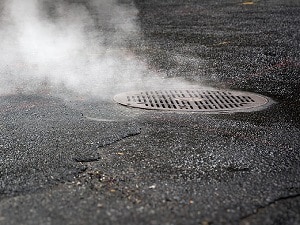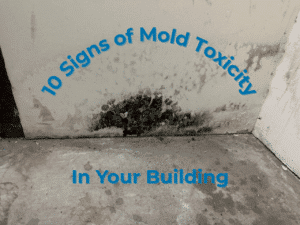The Dangers of Hydrogen Sulfide, AKA “Sewer Gas”

Hydrogen sulfide – also known as “sewer gas” – is a flammable, colorless sulfuric gas smelling of rotten eggs that, at high concentrations, is extremely hazardous to health and safety.
Managing indoor concentrations of hydrogen sulfide gas is critical to ensuring the health of building occupants and proper indoor air quality (IAQ). A naturally occurring gas, hydrogen sulfide, or “H2S,” is toxic at high concentrations. Prolonged or acute exposure to the gas can cause eye irritation, headache, nausea fatigue, and – in extreme cases – death.
Smell Sewer Gas in your building?
If you suspect that high concentrations of sewer gas have accumulated in an enclosed space, you should evacuate the area and contact the fire department for assistance. Avoid creating an ignition source such a spark from an electrical appliance, match, or cigarette lighter. – Wisconsin Dept. of Public Health
By working with an experienced environmental expert partner, property managers and building owners can take preventive measures to ensure safe indoor concentrations of hydrogen sulfide.
That “Rotten Egg” Smell is More Than Just a Nuisance
If you’ve ever walked over a sewage grate in New York or any city, you’re likely familiar with the pungent odor of hydrogen sulfide. This toxic gas is heavier than air and accumulates in low-lying and enclosed areas such as basements, sewer lines, manholes, and more.
Nicknamed the “rotten egg” smell, sewer gas, or stink damp, hydrogen sulfide gas is produced by the bacterial breakdown of organic materials – particularly in human and animal waste. H2S can also be produced in many industrial processes, including petroleum refining, agricultural processes, textile and paper manufacturing, natural gas pipe lines and mining. In low concentrations, the gas is detectable by its strong smell; however, after prolonged exposure to H2S at low levels, or after exposure at high concentrations, the ability to smell the gas is lost. Therefore, using the sense of smell is an unreliable method to determine the presence of hydrogen sulfide gas.
The primary exposure pathway of H2S is through inhalation of the gas, where it is absorbed by the lungs and may then affect various organ systems. The effects of hydrogen sulfide are listed below:
Dangers of H2S*
|
|
| Low Concentrations | Irritated eyes, nose, throat, and respiratory system, including tearing of eyes, cough, or shortness of breath. Effects may be delayed.
|
| Moderate Concentrations | Severe eye and respiratory irritation such as coughing and difficulty breathing. These symptoms may be accompanied by headache, dizziness, nausea, vomiting, and more.
|
| High Concentrations | Shock, convulsions, inability to breathe, rapid unconsciousness, coma, and even death can occur within a few breaths, or even a single breath depending on the level of concentration. |
* Per the OSHA Fact Sheet on hydrogen sulfide
Take Preventative Measures Against H2S Exposure
Bathroom facilities with poor ventilation and plumbing, leaks in natural gas pipelines, sewage and septic system leakage, and bacterial decay in restaurant grease interceptors are particularly susceptible to H2S buildup which may entrain into indoor spaces, creating a hazard for building occupants. Per OSHA guidelines, the acceptable 10-minute exposure limit of H2S is 10 parts per million (ppm). Exposure to 100+ ppm of H2S is considered Immediately Dangerous to Life and Health (IDLH).
To protect against exposure to this toxic gas, property owners should:
- Test the air for hydrogen sulfide gas concentrations
- Keep areas where H2S may build up thoroughly ventilated
- If acute H2S exposure is suspected, evacuate the area immediately
- Evaluate the plumbing, sewage system in a building
Partnering with an environmental remediation expert is the best way to test and mitigate exposure to H2S. For many environmental consultants such as Omega, this service is offered as part of an Indoor Air Quality (IAQ) assessment to ensure the health and safety of an enclosed environment. Omega’s Industrial Hygienists use direct-read air monitoring equipment to accurately detect levels of hydrogen sulfide gas that may be impacting indoor air quality.
Recently, a client of Omega’s requested an IAQ assessment to evaluate a building’s air for hydrogen sulfide. Omega conducted a full site visit to assess the area of concern, take measurements of H2S concentrations, and provide a full report on findings, recommendations, and more. Our team of industry-veteran industrial hygienists and toxicologists detected no evidence of H2S.
Related blog: Preventing and Detecting the Deadly Threat of Sewer Gas Exposure
Test Indoor Air Quality with Help from Environmental Experts
Omega’s team – comprised of scientists, toxicologists, hygienists, and other industry experts – works closely with clients to identify and mitigate environmental hazards. From hydrogen sulfide to mold, asbestos, and more, our services provide holistic assessments of potentially toxic substances.
To learn more about mitigating hydrogen sulfide and other environmental toxins, contact us.
Contact us to learn more about indoor air quality assessments










